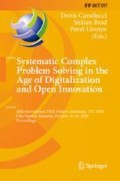Abstract
Excessiveness (redundancy) is often intentionally introduced in an engineering system (ES) in order to improve its reliability. In many cases, however, various types of excessiveness existing in an ES can be a good resource for improving the ES, whether by reducing its cost, minimizing its environmental impact, improving its compatibility with other systems, or something else. Yet modern TRIZ does not fully utilize this resource. For example, in Function Analysis (FA), although a useful function’s excessive level of performance is seen as a disadvantage, this fact is normally ignored. Additionally, the cost and quantity of substances, energy and other useful resources spent in the system are evaluated subjectively and their excessive consumption is frequently classified as “acceptable” (this could be called “hidden excessiveness”), which in the analysis leads to a loss of some key problems and related solutions. In this paper, the author is trying to enhance TRIZ Resource Analysis and FA, by (1) introducing an objective approach to identifying different hidden excesses in the ES, which includes the excessive amount of energy, substances, and other resources (e.g. bandwidth, processing power, etc.) consumed by the system, and (2) by including these excesses in the TRIZ Resource Analysis. Four case studies demonstrate the practical application of this approach in the areas of machining operations, video displays, Wi-Fi systems and computer simulation algorithms.
Access this chapter
Tax calculation will be finalised at checkout
Purchases are for personal use only
References
Bauer, E.: Beyond Redundancy. How Geographic Redundancy Can Improve Service Availability and Reliability of Computer-Based Systems, 1st edn. Wiley, Hoboken (2011)
Dubrova, E.: Fault-Tolerant Design. Springer, New York (2013). https://doi.org/10.1007/978-1-4614-2113-9
Myers, A.: Complex System Reliability: Multichannel Systems with Imperfect Fault Coverage, 2nd edn. Springer, London (2014). https://doi.org/10.1007/978-1-84996-414-2
Chybowsky, L., Matuszak, Z.: Structural redundancy in an offshore vessel dynamic positioning system. Maint. Probl. 3, 41–49 (2007)
Abramov, O.: Izbytochnost’ v tekhnicheskih sistemakh (Excessiveness in engineering systems). [Publication in Russian]. In: Proceedings of the Scientific-Practical Conference “Creativity for a Decent Life”, Velikiy Novgorod, Russia (2001). http://www.triz.natm.ru/articles/abram/abram01.htm. Accessed 02 May 2020
MATRIZ: MATRIZ – Level 1 Training Manual (2019). https://matriz.org/wp-content/uploads/2019/01/Level-1-Manual-Word.pdf. Accessed 09 May 2020
Litvin, S.: New TRIZ-based tool Function-Oriented Search (FOS). TRIZ J. (2005). https://triz-journal.com/new-triz-based-tool-function-oriented-search-fos/. Accessed 10 May 2020
Abramov, O., Markosov, S., Medvedev, A.: Experimental validation of quantum-economic Analysis (QEA) as a screening tool for new product development. In: Koziołek, S., Chechurin, L., Collan, M. (eds.) Advances and Impacts of the Theory of Inventive Problem Solving, pp. 17–25. Springer, Cham (2018). https://doi.org/10.1007/978-3-319-96532-1_2
Abramov, O.: TRIZ-based cause and effect chains analysis vs root cause analysis. In: Proceedings of the 11th International Conference TRIZFest-2015, Seoul, South Korea, pp. 283–291 (2015). http://matriz.org/wp-content/uploads/2012/07/TRIZfest-2015-conference-Proceedings.pdf. Accessed 09 May 2020
Russo, D., Regazzoni, D., Montecchi, T.: Eco-design with TRIZ laws of evolution. Proc. Eng. 9, 311–322 (2011). https://www.sciencedirect.com/science/article/pii/S187770581100138X. Accessed 04 Aug 2020
Moradnazhad, M., Unver, H.: Energy efficiency of machining operations: a review. Proc. Inst. Mech. Eng. Part B: J. Eng. Manuf. 1–19 (2016). https://www.researchgate.net/publication/292213278_Energy_efficiency_of_machining_operations_A_review. Accessed 10 May 2020
Abramov, O. et al.: Switched Multi-Beam Antenna. US Patent 7,215,296, May 8, 2007 (2007)
‘Miniature Smart Antenna Wins Innovation Award’. Electronic Design (2007). http://electronicdesign.com/energy/miniature-smart-antenna-wins-innovation-award. Accessed 20 May 2020
Morrison, G.: 8K TV: What you need to know [Online article]. CNET Website (2020). https://www.cnet.com/news/8k-tv-what-you-need-to-know/. Accessed 11 May 2020
Clark, R.: Notes on the resolution and other details of the human eye [Online article]. Clarkvision Website (2005). https://clarkvision.com/imagedetail/eye-resolution.html. Accessed 11 May 2020
Fraiman, M.: What is the resolution of the human eye? [Online article]. PictureCorrect, Inc. (2014). https://www.picturecorrect.com/tips/what-is-the-resolution-of-the-human-eye/. Accessed 11 May 2020
‘Spin Echo’ (2020). https://en.wikipedia.org/wiki/Spin_echo. Accessed 12 May 2020
Tarkhanov, V.: Operating principle of a spin-echo processor. [Publication in Russian] Nauchnoe Priborostroenie 13(1), 51–57 (2003). http://iairas.ru/mag/2003/full1/Art7.pdf. Accessed 12 May 2020
Pleshakov, I.V., Popov, P.S., Dudkin, V.I., Kuz’min, Y.I.: Spin echo processor in functional electronic devices: control of responses in processing of multipulse trains. J. Commun. Technol. Electron. 62(6), 583–587 (2017). https://doi.org/10.1134/S1064226917060171
Bushong, S., Clarke, G.: Magnetic Resonance Imaging: Physical and Biological Principles, 4th edn. Mosby, USA (2014)
Campbell, G., Ferguson, K., Sellars, M., Buchler, B., Lam, P.: Echo-based quantum memory. In: Bruss, D., Leuchs, G. (eds.) Quantum Information: From Foundations to Quantum Technology Applications, 2nd edn. Wiley-VCH, Weinheim (2019). https://arxiv.org/pdf/1902.04313v1.pdf. Accessed 12 May 2020
‘Bloch Equations’ (2019). https://en.wikipedia.org/wiki/Bloch_equations. Accessed 14 May 2020
Hazra, A., Lube, G., Raumer, H.: Numerical simulation of Bloch equations for dynamic magnetic resonance imaging. Appl. Numer. Math. 123, 241 (2018). https://www.sciencedirect.com/science/article/abs/pii/S0168927417302015?via%3Dihub. Accessed 14 May 2020
Abramov, O., Karpenkov, M.: Chislenniy raschet signalov spinovogo ekha (Numerical calculation of spin echo signals). [Publication in Russian]. In: LETI News, Collection of Scientific Papers, Leningrad Lenin Electrotechnical Institute, vol. 447, pp. 3–9 (1992)
‘Nyquist–Shannon Sampling Theorem’ (2020). https://en.wikipedia.org/wiki/Nyquist%E2%80%93Shannon_sampling_theorem. Accessed 16 May 2020
Govindarajan, H., Sheu, D., Mann, D.: Review of systematic software innovation using TRIZ. Int. J. Syst. Innov. 5(3), 72–90 (2019)
Schlueter, M.: Fast software by TRIZ. In: Proceedings of ETRIA World Conference TRIZ Future 2003, Aachen, Germany, 12–14 November 2003 (2003)
Hartmann, H., Vermeulen, A., Beers, M.: Application of TRIZ in software development. TRIZ J. (2004). https://triz-journal.com/application-triz-software-development/. Accessed 06 May 2020
Abramov, O.Y., Medvedev, A.V., Rychagov, V.Y.: Evaluation of the effectiveness of modern TRIZ based on practical results in new product development. In: Benmoussa, R., De Guio, R., Dubois, S., Koziołek, S. (eds.) TFC 2019. IAICT, vol. 572, pp. 36–44. Springer, Cham (2019). https://doi.org/10.1007/978-3-030-32497-1_4
Author information
Authors and Affiliations
Corresponding author
Editor information
Editors and Affiliations
Rights and permissions
Copyright information
© 2020 IFIP International Federation for Information Processing
About this paper
Cite this paper
Abramov, O. (2020). Excesses in Engineering Systems: A Helpful Resource. In: Cavallucci, D., Brad, S., Livotov, P. (eds) Systematic Complex Problem Solving in the Age of Digitalization and Open Innovation. TFC 2020. IFIP Advances in Information and Communication Technology, vol 597. Springer, Cham. https://doi.org/10.1007/978-3-030-61295-5_13
Download citation
DOI: https://doi.org/10.1007/978-3-030-61295-5_13
Published:
Publisher Name: Springer, Cham
Print ISBN: 978-3-030-61294-8
Online ISBN: 978-3-030-61295-5
eBook Packages: Computer ScienceComputer Science (R0)


